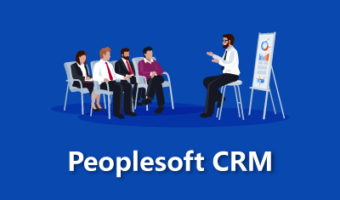PEOPLESOFT TECHNICAL
About This Course

Course Overview :
Peoplesoft Technical deals with PeopleCode,PeopleTools .PeopleCode is an (ool) object-oriented proprietary (case-insensitive) language used to express business logic for PeopleSoft applications. In its fundamentals, PeopleCode syntax resembles other programming languages.PeopleTools is the proprietary software development environment that was created by the PeopleSoft Corporation.
Prerequisites
Course Content
- Peopletools
- Navigating PeopleSoft Applications
- Using Search Pages
- Identifying Definitions
- Entering and Modifying Data
- Finding Information Using PeopleBooks
- Explaining PeopleSoft Architecture
- Describing PeopleSoft Databases
- Explaining Data Transfer in PeopleSoft Pure Internet Architecture
- Identifying Requirements for the Development Environment
- Organizing Data
- Describing Relational Data Models
- Normalizing Data
- Reading Data Models
- Validating Data
- Describing Prompt Tables
- Using Effective Dating
- Comparing Validation Types
- Explaining Tableset Sharing
- Developing Applications by Using the Eight Steps
- Describing the PeopleSoft Application Development Process
- Describing the Application Designer Interface
- Organizing Definitions in a Project
- Designing the Application
- Planning the Application
- Determining Functional Specifications
- Determining Technical Specifications
- Describing the Training Application
- Defining Fields
- Discussing Fields in PeopleSoft Applications
- Identifying Field Definition Types and Properties
- Creating Field Definitions
- Assigning Translate Values
- Creating Record Definitions
- Discussing Fields in PeopleSoft Applications
- Identifying Field Definition Types and Properties
- Creating Field Definitions
- Assigning Translate Values
- Building SQL Tables
- Describing the Relationship Between Record Definitions and Application Data Tables
- Building Application Data Tables
- Viewing Table Indexes
- Creating Page Definitions
- Identifying Page Design Principles
- Identifying Page and Page Control Properties
- Adding Page Controls to a Page
- Creating Page Definitions
- Implementing Scroll Areas and Grids
- Defining Components
- Defining Component Properties
- Building New Components
- Registering Components
- Examining Menu Definitions
- Identifying PeopleSoft Security Basics
- Navigating the Portal Registry
- Registering a Component
- Testing an Application
- Creating and Analyzing Test Plans
- Troubleshooting Common Issues
- Editing the Registry Structure
- Discussing Content Organization in PeopleTools Navigation
- Creating Folders
- Moving Folders or Content References to New Parent Folders
- Creating Menu Definitions
- Describing the Purpose of a Menu
- Locating a Component on a Menu
- Editing Menu Item Labels
- Analyzing the Impact of Design Changes
- Determining Relationships Among Definitions
- Synchronizing Record Definitions and Database Tables
- Incorporating Upgrades in the Development Strategy
- Searching Applications by Using the Verity Search Engine
- Describing and Performing a Verity Search
- Generating a Registry Search Collection
- Adding Keywords to a Search Collection
- Performing Data Audits
- Discussing Advantages and Disadvantages of Implementing Audits
- Implementing Field-Level Audits
- Implementing Record-Level Audits
- Importing and Exporting Projects
- Describing How Projects Transport Definitions Between Databases
- Exporting Projects
- Navigating PeopleSoft Applications
- Peoplecode
- Object Scroll functions in detail (accessing and updating scroll levels 1 to 3).
- PeopleCode in depth
- Component buffer and data buffer classes and functions in detail – passing objects as Parameters.
- Component interface in detail.
- Trace the delivered pages in order to customize the delivered panels.
- Application engine in detail – parallel processing using temp tables, restart logic, tracing etc.”
- Workflow technology
- Integration Broker basics.
- Audit and migrating changes across environments.
- XML Publisher.


